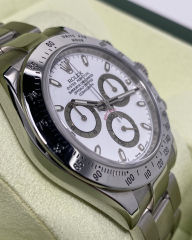Grailzee's Guide to Watch Auction Photography
When selling your watch online, presentation is everything.
The quality of your photos can make the difference between an excellent result and an average one. For the purposes of this guide, we will be using two resources anyone can afford: a lightbox ($100-150 on Amazon) and a cell phone (iPhone 11 pro).
Not confident in your ability to take photos after reading through this guide? Consider our Premium or White Glove service and we'll take the burden of presentation off your hands.
Example Gallery
This gallery demonstrates strong framing, lighting, angles, and background choice. Note how the focused area is the same size in every image, and that the colors are true.

1. Start with a clean watch
Depending on the condition of your timepiece, multiple strategies may be necessary to get your piece photo ready. At minimum, we recommend gently wiping the surfaces of your watch with a microfiber cloth to remove any handling marks.
For watches with more grime, a short soak in a bowl of lukewarm water and a small drop of antibacterial dish soap should break down most of the buildup and the rest can be wiped away.
Note – a clean watch does not mean a perfect watch. Watches are made to be worn, and if yours has visible imperfections, it's important to show them as it reflects positively on your integrity as a seller.









2. Plan your shots
Here are the shots we recommend at minimum.
- Straightforward dial picture
- Closeup of hands and dial (optional Macro lens helps with these)
- Both sides of the case
- Angles of lugs (this is where watches take the most damage)
- Crystal photo (try to show imperfections
- Caseback & movement (if applicable)
- Clasp
- Bracelet/strap (if applicable, ensure its possible to count the number of links)
- Bracelet stretch/flex (if applicable)
- Watch with box and manuals
- Additional accessories
- Lume shot (if applicable)
It never hurts to add extra angles and perspectives depending on the watch and its features. Better too many than too few.

3. Time to shoot!
Before you start firing away, take your cloth and wipe off your phone's camera lenses to make sure there are no smudges that might affect your ability to focus on your watch.
Make sure your framing is centered so that there is the same amount of negative space left & right, top & bottom.
When shooting in any light, you want to make sure the light does not reflect directly on the crystal or “blow out” (overexpose) any parts of the watch. This is why bigger can be better for your lightbox – you'll get more flexibility to move around and avoid harsh light. We recommend at least 24x24x24 inches.
Before you move on to your next shot, remember: “Two is one, and one is none”. Always take a backup photo in case something is off with your first one.
Pro Tip: Zoom in to 2x to give you more flexibility to get a clean shot without your light source or cell phone reflection in the photo.







4. Editing
There are many apps available that allow you to edit your photos, however, the ones built into your phone are usually just fine.
Editing is not meant to make your piece look better than it is, but to bring truth to your photos. You'll want to adjust things like exposure (how light or dark your photo is), warmth (subtle color adjustments), saturation, and sharpness (don't overdo this one).
Here's a good before and after of slight adjustments on this Rolex Daytona using only the settings described above.

5. Serial Number
Take a photo of the card/papers showing serial number, and, if possible, the serial number on the watch itself to prove they are matching.
(NOTE – we will not expose the full serial number on your auction, but oftentimes need it for verification purposes).


6. Video
After getting your still photos, it’s helpful to also take a flattering video of your timepiece to entice more bidders.
If you're shooting in natural light, it’s best to do so in the morning or evening when the light is softer. For those using a lightbox, maneuver and position the watch in a way that reduces harsh reflections.
Make sure to capture all around the watch and strap/bracelet, with extra focus on the case, dial, crystal, and clasp. This allows potential buyers to both see the beauty of your timepiece as well as any patina and signs of wear.